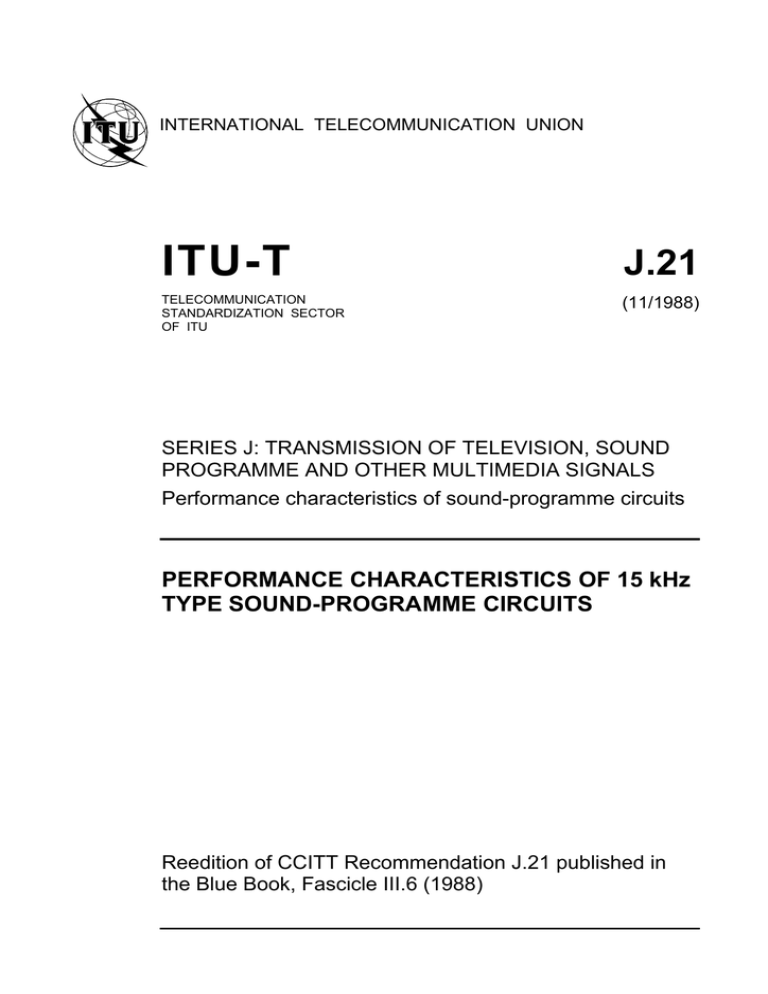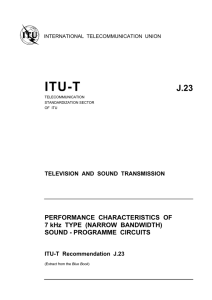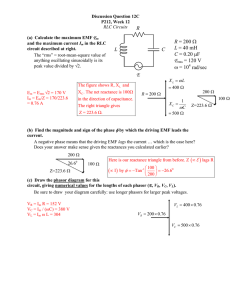
INTERNATIONAL TELECOMMUNICATION UNION
ITU-T
J.21
TELECOMMUNICATION
STANDARDIZATION SECTOR
OF ITU
(11/1988)
SERIES J: TRANSMISSION OF TELEVISION, SOUND
PROGRAMME AND OTHER MULTIMEDIA SIGNALS
Performance characteristics of sound-programme circuits
PERFORMANCE CHARACTERISTICS OF 15 kHz
TYPE SOUND-PROGRAMME CIRCUITS
Reedition of CCITT Recommendation J.21 published in
the Blue Book, Fascicle III.6 (1988)
NOTES
1
CCITT Recommendation J.21 was published in Fascicle III.6 of the Blue Book. This file is an extract from the
Blue Book. While the presentation and layout of the text might be slightly different from the Blue Book version, the
contents of the file are identical to the Blue Book version and copyright conditions remain unchanged (see below).
2
In this Recommendation, the expression “Administration” is used for conciseness to indicate both a
telecommunication administration and a recognized operating agency.
© ITU 1988, 2007
All rights reserved. No part of this publication may be reproduced, by any means whatsoever, without the prior written
permission of ITU.
Recommendation J.211
PERFORMANCE CHARACTERISTICS OF 15 kHz TYPE
SOUND-PROGRAMME CIRCUITS2
Circuits for high-quality monophonic
and stereophonic transmissions
(Geneva, 1972; amended at Geneva, 1976 and 1980, and
at Melbourne, 1988)
The CCITT,
considering
(a) that it is necessary to set transmission standards for sound-programme circuits;
(b) that quality requirements for the hypothetical reference circuit are established for analogue sound
programmes;
(c) that advantage should be taken of the technical evolution made possible by the introduction of digital
techniques, particularly for mixed analogue and digital circuits,
recommends
that, with due regard to the application constraints, equipment for new circuits meet the requirements laid out
below.
1
Application
The Recommendation applies to homogeneous analogue or mixed analogue-and-digital circuits.
The requirements below apply to the hypothetical reference circuit (HRC) defined in Recommendation J.11.
For estimation of the performance of circuits shorter or longer than the HRC, see CCIR Recommendation 605.
Note 1 – For all-digital circuits a separate Recommendation might be envisaged after further study.
Note 2 – For further work, CCIR Report 496 may be consulted. This Report also draws attention to certain
differences between CCIR and OIRT Recommendations.
2
Interface characteristics
2.1
Test conditions
When circuit performance is to be measured, the system output shall be terminated by a balanced test load,
nominally 600 Ω resistive.
2.2
Impedance
System input impedance
600 Ω, balanced3
System output impedance, provisionally
Low, balanced
____________________
1 This Recommendation corresponds to CCIR Recommendation 505.
2 For the definition of absolute power, relative power and noise levels, see CCIR Recommendation 574.
3 The tolerance, permitted reactance and degree of unbalance need further study.
Fascicle III.6 – Rec. J.21
1
The open-circuit output level shall not decrease more than 0.3 dB within the nominal frequency range, if the
output is terminated by the specified test load.
The reactive part of the source impedance must be restricted to 100 Ω max. (provisional value) within the
nominal frequency range.
This clause alone would however not rule out a large difference in the reactive parts of the output impedances
of a stereophonic pair, and this in turn could lead to difficulties in meeting § 3.2.2. This aspect needs further study.
2.3
Levels
Input maximum programme level
+9 dBm0s
Insertion gain (1 kHz at –12 dBm0)
0 dB
Adjustment error, within
± 0.5 dB
Variation over 24 hours not to exceed
± 0.5 dB
Relative level (see Recommendation J.14)
+6 dBrs
If the broadcast organizations wish to have closer tolerances, it is necessary for the receiving broadcasting
organizations to insert additional trimming attenuators.
3
Overall performance
3.1
Common parameters
3.1.1
Gain/frequency response
Reference frequency
1 kHz (nominal value)
The response shall be measured at
–12 dBm0s
The gain/frequency response is given in Table 1/J.21.
If broadcasting organizations wish to have closer tolerances, it is necessary for the receiving broadcasting
organization to insert additional equalizers.
TABLE 1/J.21
Frequency
(kHz)
3.1.2
Response
(dB)
0,04 ≤ f < 0,125
+0,5 to –2,0
0,125 ≤ f ≤ 10
+0,5 to –0,5
10
< f ≤ 14
+0,5 to –2,0
14
< f ≤ 15
+0,5 to –3,0
Group delay variation
Difference ∆τ, between the value of group delay at certain frequencies and the minimum value is given in
Table 2/J.21. Between the points defined in Table 2/J.21, the tolerance limit varies linearly on a linear-delay/logarithmic
frequency diagram.
2
Fascicle III.6 – Rec. J.21
TABLE 2/J.21
kHz
3.1.3
∆τ (ms)
0,04
55
0,075
24
14
8
15
12
Noise
The measurement to be made with an instrument conforming to CCIR Recommendation 468.
For radio-relay systems the requirements of Table 3/J.21 shall be met for at least 80% of the total time of any
30-day period. For 1% of the time an additional impairment of 4 dB, and for 0.1% of the time an additional impairment
of 12 dB is acceptable.
Programme-modulated noise can only occur on sound-programme circuits which are equipped with
compandors (for example types of circuits corresponding to Recommendation J.31).
This noise value may be measured with the aid of an auxiliary sinusoidal test signal +9 dBm0s/60 Hz which
has to be suppressed by a high-pass filter (f0 ≤ 400 Hz, a ≥ 60 dB/60 Hz) before the measuring set.
CCIR Report 493 indicates that if a compandor is used, an improved signal-to-noise ratio is necessary to avoid
objectionable effects with some programme material4.
Note – For digital systems appropriate values are under study. For further information see CCIR Report 647.
TABLE 3/J.21
Transmission system
Noise
3.1.4
Analogue
Digital
(3 codecs cascaded)
Idle channel noise (dBq0ps), max
–42
–51
Programme-modulated noise (dBq0ps), max
–30
–39
Single tone interference
Level of any individual tone:
≤ (–73 + ψ) dBm0s
where ψ is the weighting factor (positive or negative) as per CCIR Recommendation 468 at the particular frequency.
For sound-programme transmissions over carrier systems, occurrence of carrier leaks can be expected. For this
reason, stop filters may be provided in the carrier frequency path which can be switched in, if required, to suppress the
tones otherwise audible in the upper frequency range from 8 to 15 kHz. For a hypothetical reference circuit, a 3 dB
bandwidth of less than 3% for stop filters, referred to the mid-frequency, is recommended. The use of stop filters
influencing frequencies below 8 kHz should be avoided.
____________________
4 Administrations are urged to supply additional information on an appropriate value.
Fascicle III.6 – Rec. J.21
3
3.1.5
Disturbing modulation by power supply
The level of the strongest unwanted side component due to modulation caused by low-order interference
components from 50 Hz or 60 Hz mains shall be less than –45 dBm0s with a test signal of 1 kHz at alignment
level 0 dBm0s.
3.1.6
Non-linear distortion
3.1.6.1
Harmonic distortion
The total harmonic distortion (THD) shall be measured with the input signal at +9 dBm0s for frequencies up to
2 kHz at +6 dBm0s for frequencies above 2 kHz up to 4 kHz.
The duration for which a single-tone is to be transmitted at these levels should be restricted in accordance with
Recommendations N.21 and N.23.
The THD when measured with a true-RMS meter shall not be less than the following requirements shown in
Table 4/5.21.
TABLE 4/J.21
Input frequency
(kHz)
Total harmonic distorsion
Second and third harmonic
measured selectively
0,04 ≤ f < 0,125
1% (–31 dBm0s)
0,7% (–34 dBm0s)
0,125 ≤ f ≤ 2,0
0,5% (–37 dBm0s)
0,35% (–40 dBm0s)
< f ≤ 4,0
0,5% (–40 dBm0s)
0,35% (–43 dBm0s)
2,0
3.1.6.2
Intermodulation
With input signals at 0.8 kHz and 1.42 kHz, each at a level of +3 dBm0s, the third order difference tone at
0.18 kHz shall be less than 0.5% (–43 dBm0s).
Note – Attention is drawn to the fact that in transmission systems using compandors, a 3rd order differencetone may occur which exceeds the specified limit of 0.5%. This may occur when the difference between the two
fundamental frequencies is less than 200 Hz. Thus, the components due to 3rd order distortion will have frequencies
which correspond to the difference between the two test frequencies. However, in these cases the subjective masking is
such that a distortion up to 2% is acceptable.
For 15 kHz systems intended for baseband transmissions on physical circuits only, and on modulation
equipment in local loops, assuming no pre-emphasis, the additional requirements of Table 5/J.21 apply.
TABLE 5/J.21
3.1.6.3
Input signals at +3 dBm0s each
Maximum difference-tone level at 1.6 kHz
5,6 kHz and 7,2 kHz
0,5% (–43 dBm0s)
(second order)
4,2 kHz and 6,8 kHz
0,5% (–43 dBm0s)
(third order)
Distortion products measured by shaped noise
Under study. See CCIR Report 640 (Kyoto, 1978).
4
Fascicle III.6 – Rec. J.21
3.1.7
Error in reconstituted frequency (applies only to FDM systems)
Not to be greater than 1 Hz.
Note – A maximum error of 1 Hz is in principle acceptable where there is only a single transmission path
between the signal source and the listener.
Where the broadcast network can involve two or more parallel paths, e.g. the left and right channels of a stereo
signal, commentary and separate sound channels, or radio broadcast from different transmitters on the same frequency,
unacceptable beats may occur unless zero error can be assured. This is under study.
3.1.8
Intelligible cross-talk ratio
3.1.8.1 The intelligible near-end and far-end cross-talk ratios between sound-programme circuits, or from a telephone
circuit (disturbing) into a sound-programme circuit (disturbed) shall be measured selectively in the disturbed circuit at
the same frequencies as those of the sinusoidal test signal applied to the disturbing circuit, and shall not be less than the
values of Table 6/J.21.
TABLE 6/J.21
Frequency
(kHz)
f = 0,04
0,04 < f < 0,05
0,05 ≤ f ≤ 5
5
Crosstalk attenuation
(dB)
50
Oblique straight-line segment on linear-decibel and
logarithmic-frequency scales
74
< f < 15
Oblique straight-line segment on linear-decibel and
logarithmic-frequency scales
f = 15
60
3.1.8.2 The near-end and far-end cross-talk attenuations between a sound-programme circuit (disturbing circuit) and a
telephone circuit (disturbed circuit) shall be at least 65 dB.
Note 1 – It is understood that this value is defined between the relative levels applicable to telephone circuits.
(Administrations are invited to submit contributions on methods for measuring this parameter.)
Note 2 – The attention of Administrations is drawn to the fact that it is in some cases difficult or impossible to
meet these limits. This may occur when unscreened pairs are used for a long audio-frequency circuit (e.g. about 1000 km
or longer), or in certain carrier systems on symmetric pair cables, or at low frequencies (e.g. below about 100 kHz) on
certain coaxial cable carrier systems. If sub-standard performance is to be avoided, such systems or parts of systems,
must not be used for setting up programme channels.
Note 3 – When 4000 pW0p or more noise is continuously present in the telephone channel (this may be the
case in satellite systems, for example), a reduced cross-talk ratio of 58 dB between a sound-programme circuit and a
telephone circuit is acceptable.
Note 4 – The attention of Administrations is drawn to the fact that, because of cross-talk which may occur in
terminal modulating and line equipment, special precautions may have to be taken to meet the above cross-talk limits
between two sound-programme circuits, simultaneously occupying the go and return channels respectively, of a carrier
system (the most economical arrangement) because in those circumstances they occupy the same position in the linefrequency band (see Recommendation J.18).
Note 5 – The value indicated is based on the assumption that sine wave test signals are used. The use of the test
signal as described in Recommendation J.19 is under study.
Note 6 – The effect of cross-talk from a sound-programme circuit into a telephone circuit is not a question of
secrecy, but rather of subjective disturbance by an interfering signal whose character is noticeably different from random
noise or babble.
Fascicle III.6 – Rec. J.21
5
The frequency offset adopted for some sound-programme equipment allows a reduction of cross-talk from a
telephone circuit into a sound-programme circuit. However, in the reverse direction, this reduction of cross-talk remains
only for speech material but is practically ineffective for music material.
3.1.9
Amplitude linearity
When a 1 kHz input signal is stepped from –6 dBm0s to +6 dBm0s, or vice versa, the output level shall change
accordingly by 12 ± 0.5 dB.
3.2
Additional parameters for stereophonic programme transmission
3.2.1
The difference in gain between A and B channels shall not exceed the values in Table 7/J.21.
TABLE 7/J.21
Frequency
(kHz)
3.2.2
Gain difference
(dB)
0,04 ≤ f < 0,125
1,5
0,125 ≤ f ≤ 10
0,8
10
< f ≤ 14
1,5
14
< f ≤ 15
3,0
The phase difference between the A and B channels shall not exceed the values in Table 8/J.21.
TABLE 8/J.21
Frequency
(kHz)
Phase difference
(degrees)
f = 0,04
30
0,04 < f < 0,2
Oblique straight-line segment on linear-degree and
logarithmic-frequency scales
0,2 ≤ f ≤ 4
15
4
< f < 14
Oblique straight-line segment on linear-degree and
logarithmic-frequency scales
0,04 < f = 14
14
< f < 15
30
Oblique straight-line segment on linear-degree and
logarithmic-frequency scale
0,04 < f = 15
40
3.2.3
The cross-talk ratio between the A and B channels shall not be less than the following limits:
3.2.3.1
Intelligible cross-talk ratio, measured with sinusoidal test signal 0.04 to 15 kHz: 50 dB.
3.2.3.2
Total cross-talk ratio predominantly caused by intermodulation: 60 dB.
This value is ascertained by loading one of the two channels with the sound-programme simulating signal
defined in CCIR Recommendation 571. In the other channel, the noise contribution due to intermodulation shall not be
higher than –51 dBq0ps.
This leads to an increase of noise depending on the idle channel noise value. The tolerable increase is given Table 9/J.21.
6
Fascicle III.6 – Rec. J.21
TABLE 9/J.21
3.3
Idle channel noise (dBq0ps)
–60
–57
–54
–51
–48
–45
–42
Tolerable increase of noise (dB)
9,5
7
4,8
3
1,8
1,0
0,5
Additional requirements for digital systems
3.3.1
If a test signal is harmonically related to the sampling frequency, measuring difficulties may arise. In that case
the nominally 1 kHz test signal must be offset. Recommendation O.33 recommends 1020 Hz.
3.3.2
Unbalance of the limitation level
The difference between those levels which lead to a limitation of the positive or negative half-wave of the test
signal shall not exceed 1 dB.
3.3.3
Intermodulation with the sampling signal
Intermodulation products (fd) caused by non-linearities may occur in the sound-channel when the sampling
signal signal (fo) is combined with the inband audio signals (fi) or out-of-band interfering signals (fa).
3.3.3.1
Inband intermodulation
The following combination rule applies: fd = fo – nfi.
Only values with n = 2 or 3 are of importance.
40 dB.
The level difference between a 0 dBm0s signal (fi) and the intermodulation products (fd) shall not be less than
A restriction to the fi/fd values in Table 10/J.21 is sufficient.
TABLE 10/J.21
n=2
3.3.3.2
n=3
fi (kHz)
9
13
7
11
fd (kHz)
14
6
11
1
Out-of-band intermodulation
The following combination rule applies: fd = nfo ± fa.
Only values with n = 1 or 2 are of importance.
60 dB.
The level difference between a 0 dBm0s signal (fa) and the intermodulation products (fd) shall not be less than
A restriction to the fa/fd values in Table 11/J.21 is sufficient.
TABLE 11/J.21
n=1
fa (kHz)
fd (kHz)
31
n=2
33
63
65
1
Fascicle III.6 – Rec. J.21
7
3.3.4
Further parameters
Characteristics for bit errors, clicks, jitter, etc. are under study. (See Study Programme 18A/CMTT and
CCIR Report 647.)
Note – The CCIR has issued Recommendation 572 which deals with the transmission of one sound-programme
associated with an analogue television signal by means of time-division multiplex in the line synchronizing pulse. The
system recommended is a digital one, using pulse code modulation. A sound-programme bandwidth of 14 kHz is
provided.
Bibliography
CCIR Document (1978-1982): CMTT/68 (OIRT).
8
Fascicle III.6 – Rec. J.21
ITU-T J-SERIES RECOMMENDATIONS
TRANSMISSION OF TELEVISION, SOUND PROGRAMME AND OTHER MULTIMEDIA SIGNALS
General Recommendations
J.1–J.9
General specifications for analogue sound-programme transmission
J.10–J.19
Performance characteristics of analogue sound-programme circuits
J.20–J.29
Equipment and lines used for analogue sound-programme circuits
J.30–J.39
Digital encoders for analogue sound-programme signals
J.40–J.49
Digital transmission of sound-programme signals
J.50–J.59
Circuits for analogue television transmission
J.60–J.69
Analogue television transmission over metallic lines and interconnection with radio-relay links
J.70–J.79
Digital transmission of television signals
J.80–J.89
Ancillary digital services for television transmission
J.90–J.99
Operational requirements and methods for television transmission
J.100–J.109
Interactive systems for digital television distribution
J.110–J.129
Transport of MPEG-2 signals on packetised networks
J.130–J.139
Measurement of the quality of service
J.140–J.149
Digital television distribution through local subscriber networks
J.150–J.159
For further details, please refer to ITU-T List of Recommendations.
ITU-T RECOMMENDATIONS SERIES
Series A
Organization of the work of the ITU-T
Series B
Means of expression: definitions, symbols, classification
Series C
General telecommunication statistics
Series D
General tariff principles
Series E
Overall network operation, telephone service, service operation and human factors
Series F
Non-telephone telecommunication services
Series G
Transmission systems and media, digital systems and networks
Series H
Audiovisual and multimedia systems
Series I
Integrated services digital network
Series J
Transmission of television, sound programme and other multimedia signals
Series K
Protection against interference
Series L
Construction, installation and protection of cables and other elements of outside plant
Series M
TMN and network maintenance: international transmission systems, telephone circuits,
telegraphy, facsimile and leased circuits
Series N
Maintenance: international sound programme and television transmission circuits
Series O
Specifications of measuring equipment
Series P
Telephone transmission quality, telephone installations, local line networks
Series Q
Switching and signalling
Series R
Telegraph transmission
Series S
Telegraph services terminal equipment
Series T
Terminals for telematic services
Series U
Telegraph switching
Series V
Data communication over the telephone network
Series X
Data networks and open system communications
Series Y
Global information infrastructure and Internet protocol aspects
Series Z
Languages and general software aspects for telecommunication systems
Printed in Switzerland
Geneva, 2007
2007



